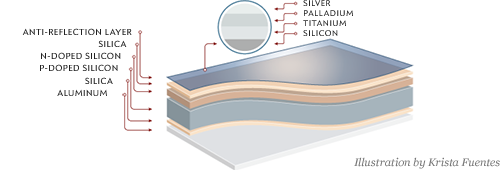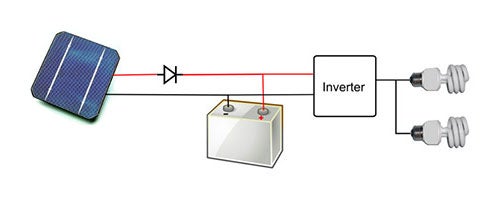How Solar Panels Work [Infographic]

1. Semiconductor
The scintillating crystals of silicon in each cell are the core of these devices. (The silicon appears blue because of an antireflection coating.) Each panel contains a grid of many such silicon solar cells, and the silicon itself is doped with other chemicals so that it can generate a current when hit by light.
Photo courtesy of futureatlas

2. Wiring
An electrical current is only useful in a circuit that allows it to flow to where it can be put to work. Solar panels include a cross-hatch of metallic material, typically made from silver or copper, that conduct the electricity away from the solar cells.
Photo courtesy of Andreas Demmelbauer

3. Current
On striking a crystal in the panel, an incoming photon from the sun dislodges a spare electron in the silicon layer that has been chemically tweaked to donate electrons, which allows them to roam (referred to as the N-doped silicon). That electron migrates down to an adjacent layer of silicon that has been treated to accept the negative particle (P-doped silicon), thereby creating an electric current. But silicon can only transform the energy of certain wavelengths of light. An antireflective coating composed of thin layers of metals like silver gives the panel its blue hue and ensures that stray photons are redirected back into the photovoltaic silicon layers. A reflective aluminum backing serves a similar role for sunlight that penetrates through the cell as well as provides structural support.

4. Grid Connection
A single solar cell becomes useful when connected to a device powered by electricity, whether a motor or a lightbulb. Typical solar power systems also include an inverter to convert direct current to the alternating current used in a home, as well as, potentially, batteries to store solar electricity.
Photo courtesy of MikieMike

